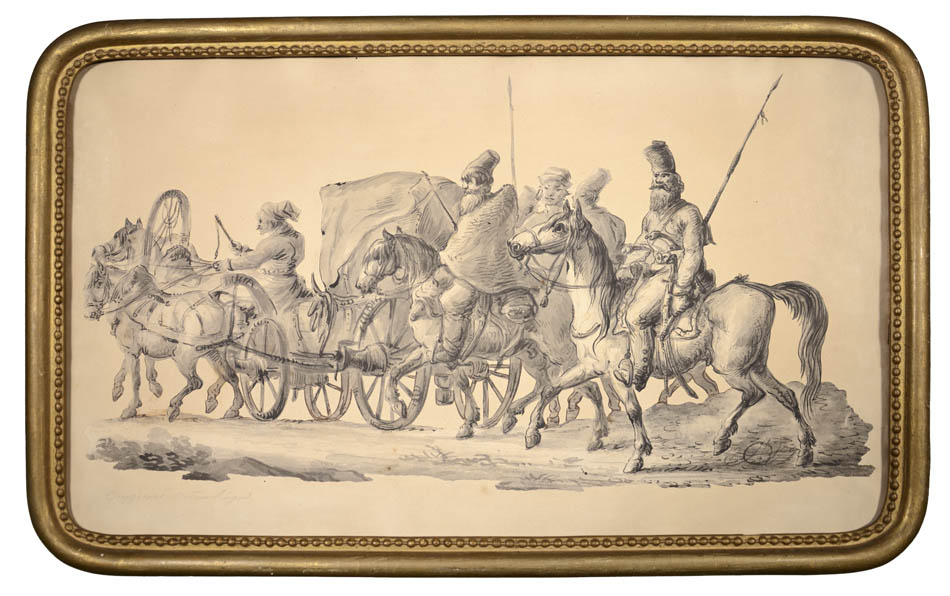ORLOWSKI, Alexandre.
Cossacks escorting a convoy.
Cossacks escorting a convoy.
Stock Code 92583
1799.
Alexander Orlowski (1777 – 1832) was a Polish painter and lithographer. Of modest birth, his artistic talents grew from a very young age, and he was soon discovered by Izabela Czartoryska, a Polish aristocrat, art collector and writer who founded Poland's first museum in Krakow. Czartoryska financed Orlowski's artistic training with the French painter Jean Pierre Norblin, court artist to the Czartoryska family. At the age of 16, Orlowski decided to volunteer to fight in the Kościuszko insurrection. Wounded in battle, he returned to Warsaw, where Prince Józef Poniatowski financed the rest of his artistic studies. Orlowski lived in Poniatowski's Palace and was expected to make entertaining portraits and sketches of the prince's guests for their entertainment. In 1802 he moved to St. Petersburg. His drawings were well received at court, and in 1819, after a period travelling around Russia, Orlowski was awarded an official position in the Russian government painting military costumes. Orlowski continued sketching throughout his adventures.
This drawing is an early example of the theme that was to bring Orlowski fame and recognition in the coming years. Although not imbued with the same confidence and boldness of touch as his later work, it already reveals the potential that made Pushkin remember the artist in his Путешествие в Арзрум [Journey to Arzrum]: 'У кибиток… пасутся уродливые, косматые кони, знакомые вам по прекрасным рисункам Орловского' [By the tents were freakish, shaggy horses, which you would recognise from the beautiful drawings of Orlovskii]. Ten years later Orlowski returned to the subject of on-duty Cossacks in his painting Bivuak kazakov, for which he was awarded the title of academician by the St. Petersburg Academy of Arts.
Examples of Orlowski's early original drawings before his relocation to St. Petersburg in 1802 are exceptionally rare.
Original découpage drawing in ink and wash on paper, signed with monogram and dated '17 AO 99' in lower right corner, the découpage executed at an early date, laid on paper, 37 x 62 cm (14 1/2 x 24 3/8 in), in contemporary gilt beaded baguette frame with rounded corners.
Couldn't load pickup availability
Provenance
Provenance
Delivery
Delivery
We offer secure and express delivery on all local and international orders of rare books, maps and prints placed through this website.
About us
About us
Shapero Rare Books is an internationally renowned dealer in antiquarian & rare books and works on paper.
Our Bookshop and Gallery can be found in the heart of Mayfair at 94 New Bond Street, where most of our stock is available to view and on public display.
We exhibit at major international art fairs, including TEFAF (Maastricht and New York), Frieze Masters, Art Miami and Masterpiece London, as well as antiquarian & rare book fairs including New York, Paris, London, Los Angeles, San Francisco and Hong Kong.
Ask us a question
Ask us a question





